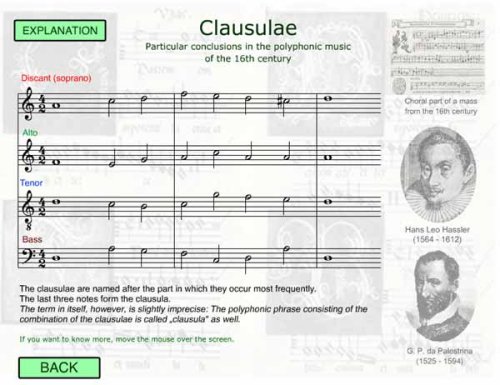“Entardecia e padre Alonzo terminava a sua aula de música. Um dos estudantes tocara ao órgão, havia pouco, uma sonatina. Depois o quarteto executara uma sarabanda, e agora o índio Rafael ali estava a tocar em sua clarineta a pavana de um compositor italiano. Havia na redução excelentes organistas, harpistas, corneteiros e clarinetistas. Tocavam composições difíceis e até trechos de í²pera italiana. Os instrumentos, em sua maioria, eram fabricados na redução pelos próprios índios, dirigidos pelos padres ”
Érico Verissimo – O tempo e o vento (I vol – O continente)
descrição de um epsódio ocorrido numa das 7 missões em 1747
Perotin and other composers created “clausulae” — polyphonic sections of discant organum that could be inserted as replacement or substitute sections of organum into a larger work. The tenor of clausulae consisted typically of a single word from the chant, so clausulae were not independent pieces. Tenor parts often used the rhythmic modes and included repetitions.
When, in the late 12th century, some unknown composers began adding new text to the duplum of a clausula, an independent piece was created apart from the liturgy. The texted line was called the “motetus.” (The French “mot” = word, indicating the presence of text different from the cantus firmus.) The pieces themselves, called “motets,” became the predominant source of interest for composers and vehicles for experimentation during the late Middle Ages. The motet drove sacred music towards secularization when occasionally a secular cantus firmus replaced the liturgical tenor as the spine of a piece. Initially the motetus was Latin, but increasingly the added lines (motetus, triplum, etc.) were secular, most often French. This music was retrospectively named “Ars Antiqua” by theorists of “Ars Nova” which followed.
The cantus firmus was still sacrosanct but without rhythmic obligation, so one could tinker with it rhythmically. “Isorhythmic” works appeared, in which a rhythmic pattern drives the piece and encounters various melodic embodiments.
French secular texts were often substituted for Latin sacred words in motets, and sometimes two and three poems were sung simultaneously. This seems to be the most complex musical form ever to appear on the face of the earth. Motet names consist of the first words of each voice in order from top to bottom voices. Thus, motets have names such as “Plus bele que flor / Quant revient / L’autrier joer / Flos Filius” — since there are four very independent texts, in different languages, for four different musical voices and lines. This particular piece superimposes a description of the shining beauty of Mary onto the evocation of an amorous encounter onto the action of God in summer, the season of love. “A Paris / On parole / Frese nouvele” offers a street-vendor’s call in the tenor (“Fresh strawberries! Nice blackberries!”) and celebrations of the wonders of Parisian life simultaneously.
Johannes de Grocheo, a theorist writing around 1300, observed that a motet “ought not to be performed in the presence of common people, for they would not perceive its subtlety, nor take pleasure in its sound.” Instead, motets should be performed only “in the presence of learned persons and those who seek after subtleties in art.” (Bonds 61)
Also lumped in with late 12th- and 13th-century Ars Antiqua is the “conductus,” a form that became more popular when it became polyphonic. A conductus is similar to a hymn but more rhythmic (triple divisions typically), typically a metrical Latin poem, not a chant melody, rendered in two to four voices and serving as a processional piece (think “Pomp and Circumstance” or the famous wedding marches for now instrumental versions serving a similar kind of function). Though syllabic, a conductus might end with a melisma, called a “cauda” (similar later to “coda”).
Also interesting as a special effect was a technique that, when used extensively, came to lend its name to the musical piece itself: the “hocket.” This is a hiccup effect used as a compositional device that breaks up the melodic line and creates a kind of quick ping-pong acoustical trick.
páginas de origem:
www.wsu.edu/~delahoyd/medieval/motets.html – 5k
musicweb.koncon.nl/overview/clausul – 8k

belo post e bem agregado com a citaÃ?§Ã?£o do Ã?©rico verÃ?Âssimo (vou comeÃ?§ar a postar as fotos da viagem pras missÃ?µes).